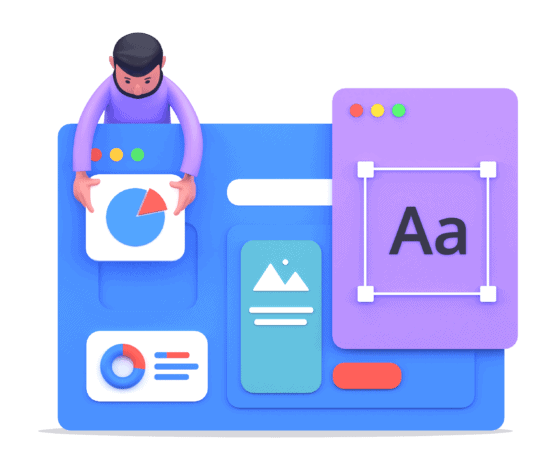
Company owners seek a silver bullet solution for perfecting website design, but when it comes to the look and feel of your website, there are a multitude of factors that can impact success and ignoring any one of them can be detrimental to how well your online presence is received.
From user experience and aesthetics to accessibility and responsiveness, every element plays an essential role in determining how effective your website will be… having said that, there is one core objective that stands above all others:
Conversions. Your business can’t survive without bringing home the bagels – whatever that might mean for your business; clicks, sales, subscriptions or likes, you need that final conversion to make it all count.
When you do all the work before that well, a user-friendly, aesthetically pleasing platform that effectively communicates a brand’s message and drives user engagement, you will get those conversions over the line more smoothly.
So, while conversions are your ultimate objective, there are many steps you need to take to earn that buttery bagel goodness.
Understanding the primary purpose of a website is crucial in crafting a design that aligns with the goals and objectives of the business. Whether it’s to increase leads, improve sales, or enhance brand visibility, a well-designed website has the power to impact the success of an organisation significantly.
By prioritising the core purpose as the cornerstone of website design, businesses can develop a strong online presence that caters to the specific needs of their target audience, resulting in greater returns on investment – win-win!
Key Takeaways
- There is no one solution to achieving website design perfection.
- Every element around website design should work towards aiding your visitor and assisting them towards their goal.
- Understanding the core purpose of your website is a critical element of effective web design.
- Aligning your website design with your business goals is crucial for success and clarity when designing or upgrading your company website.
- Continual improvement and adaptation are vital aspects of maintaining effective business website design.
Table of Contents
Understanding the Core Purpose of Your Website
Every website will have its core purpose and goals because every business will have a unique approach, reason for being, and target audience needs to meet. So before you mimic a successful website from a big brand already online, think about what your business tries to achieve with an online presence. Just because a website is successful for someone else doesn’t mean it will work for you.
Understanding the core purpose of your website is a fundamental objective that will influence your website’s size, content type, and any complex functionalities, to name a few.
So, for example, the primary purpose of an eCommerce website could be sales. This success depends on:
- Clear communication on what is being purchased
- Defined purchase value
- User-friendly checkout
- Safe and secure payment process
- Capturing lead contact information
But for a website that serves as a source of information or education, the focus would be on delivering trustworthy content that engages and informs the visitor, which would have no motivation towards sales targets.
Knowing the core purpose of a website enables the design to be tailored in a way that drives specific goals and strategies.
This approach ensures that the website becomes an integral and valuable contributor to a business or organisation. It also helps to prioritise the features and functionalities needed to enhance the user experience for better results, no matter what your big-picture website goals are.

Key Objectives for a Successful Web Presence
The key objectives for your website will have to align not just with your overall business goals but also with what your customers are looking to achieve. The best websites are the ones that create a win-win situation for everyone: You are rewarded as the owner by meeting your targets, and your customer is satisfied by the outcome they get through visiting your website, too.
There are a lot of website elements to cover, so prioritising the critical objectives of what you want to achieve ensures a solid online presence and communication that your audience will resonate with and respond to.
Here are some examples of what your key objectives might look like:
Boosting Sales and Conversions
No matter what your business does, in most cases, the primary goal of a business website is to drive sales and increase revenue or convert your readers into loyal followers in some way.
This can include acquiring email subscribers, securing sales, or generating leads. A well-designed website that prioritises user experience and ease of use can help to optimise conversion rates by making it simple for visitors to take desired actions.
To help enhance these elements, focus on innovative website design techniques businesses can foster a better user experience:
- Intuitive navigation
- Responsive design
- Clear calls-to-action
This makes it easier for customers to find and purchase your products or services, directly contributing to your business’s bottom line.
Web analytics tools can also assist in tracking and analysing user behaviour to further optimise your website for maximum conversion results.
Establishing Authority in Your Niche
All businesses must establish credibility, authority and thought leadership within their industry. This goes double for news websites, information sites and education.
To become a trusted source of information, offer valuable content such as blog posts, whitepapers and case studies, and showcase your organisation’s expertise through staff profiles, awards, accolades and speciality features.
Demonstrating your business competencies and commitment to staying informed on industry trends will help net new clients and subscriptions.
Enhancing User Engagement and Interaction
You need high engagement levels to keep people on your website for as long as possible. The longer your visitors interact with your website, the higher their trust in your brand grows, and the more likely they will revisit or transition to loyal customers.
Appealing visuals, multimedia elements, and dynamic content such as quizzes or surveys can help keep visitors interested and promote better brand experiences.
You can take it a step further by linking to social media accounts where they can comment, like, share and facilitate discussions that foster a sense of community and value to extend the brand’s reach.
Building and Reinforcing Brand Identity
Whether intended or not, your website will represent your business brand, so you want to make it a powerful extension of what you stand for.
Consistent use of colours, fonts, and messaging across your website will reinforce your brand’s unique identity and overall positioning in the market.
By ensuring that your website consistently reflects your company’s values, mission, and unique selling points, you can create lasting impressions and contribute significantly to your overall brand recognition and trustworthiness.
We build stunning, user-focused websites that will wow your customers.
Are you a business owner in Singapore, Australia or worldwide? We work with clients across the globe to deliver beautiful yet functional website designs.

Three Strategies to Achieve Your Website Objectives
User Attraction and Retention
To attract and retain users, create a visually appealing and easy-to-navigate site with a strong, clear message. You can go further to consider your website’s accessibility, optimising for various devices and incorporating features for users with disabilities.
Always keep your target audience in mind when designing, ensuring that the colours, typography, and images resonate with them – over your tastes.
Maintaining user engagement is equally important. Employ interactivity, personalised content, and relevant calls to action to engage users.
Turning Visitors into Loyal Customers
Transforming site visitors into loyal customers requires nurturing relationships and building trust. Employ a clear and consistent brand identity, ensuring that every aspect of the site conveys the brand ethos. Offer easy access to practical information, including contact details and pricing.
Encourage user reviews and testimonials and display these prominently on the site to support social proof.
If appropriate, you can offer users incentives, such as discounts or exclusive content, to encourage repeat visits.
You will need security features that offer a safe browsing experience, fostering a sense of trust and reliability with the users, especially if you are asking for payment or address details.
Leveraging Content: Blogs, Newsletters, and More
A well-executed content strategy drives user engagement, builds trust, and fosters a loyal user base. Focus on providing high-quality, informative and compelling content that resonates with the target audience.
Blogs
Blogs are a powerful tool for showcasing expertise, offering valuable knowledge to users, and establishing a brand as an industry leader. Updating the site with fresh content encourages repeat visits and improves search rankings.
Newsletters
Newsletters and email campaigns also contribute significantly by delivering personalised content to users’ inboxes. An effective email strategy engages users with exclusive offers, updates, and information while nurturing long-lasting relationships.
Analytics
Regularly evaluate the content effectiveness using analytics, as well as other feedback forms to ensure that content remains aligned with the website’s objectives and user needs.
Q&A sections
Including Q&A sections where users can post their questions and receive answers from experts in the field adds an extra layer of interaction and trust. This interactive platform can foster a sense of community and help users find the information they seek, leading to increased loyalty and satisfaction.

Digital Engagement: Nurturing Online Relationships for Long-Term Success
Website design should focus on immediate engagement and nurturing long-term relationships. Achieving this balance requires thoughtful consideration and planning to create a website that fits and stays up to date as your online presence matures.
To nurture online relationships, maintain a user-friendly interface with simple navigation options.
This encourages visitors to explore the website and return for additional information or services in the future. Furthermore, offering exceptional customer support can leave a lasting impression that improves the overall experience.
Another essential aspect of nurturing online relationships is continuously updating website content to provide fresh and relevant information. Regularly updating the website will also help boost your search engine ranking and demonstrate your active community engagement.
How Do I Pick the Right Website Design Agency?
The website design agency you choose can significantly impact the success of your website, so it’s essential to pick an agency whose goals align with your objectives and who have a structure that takes your business needs into account. The last thing you want is someone to add your logo to an existing template. Every website must be built uniquely because every business has something different to communicate.
Aligning Agency Goals with Your Objectives
Before you engage with any website professionals, write out the SMART goals and values for your website so you can discuss them and find the best fit.
Apart from feeling confident that they get what your business is striving to achieve with an online presence, here are some additional aspects to consider:
Experience
Look for an agency with relevant experience in your industry and a proven track record of success. A well-established agency typically has a better understanding of your target audience’s preferences and expectations.
Portfolio
Review the agency’s portfolio to evaluate their skills and the quality of their work. Look for examples of websites they’ve designed that have similar objectives to your own. Make sure the designs are visually appealing, user-friendly, and mobile-responsive.
Budget
Determine your web design budget and find an agency that balances quality and affordability. Be realistic about your budget, as underestimating costs can lead to compromises in the design quality or functionality.
Communication
Effective communication is vital for a successful partnership. Ensure the agency is responsive, transparent, and proactive in addressing your concerns and requirements.
Collaboration
Choose an agency open to collaboration and flexible enough to adapt its approach to your needs. A good agency will listen to your preferences and recommendations while providing expertise and advice.
Choosing the best website agency for your project will give you the green light to create a user-focused, functional, and visually appealing website that meets the needs and expectations of your target audience.

The Road Ahead: Continual Improvement and Adaptation
A big mistake in website design is a lack of flexibility for the evolving future. Digital design is a landscape constantly in motion, making continual improvement and adaptation a critical consideration.
A successful website is not merely a one-time creation but an ongoing process that evolves to meet the changing needs and expectations of users and keep up with what technology has to offer.
Here are some steps to take to stay current:
Analyse User Feedback
Consistently gather and analyse user feedback. This allows designers to identify areas of concern and make necessary adjustments, ensuring the website remains relevant and engaging to its target audience.
Access Key Metrics
Regularly evaluate a website’s performance using key metrics such as load times, bounce, and conversion rates. By closely monitoring these indicators, designers can have a better understanding of how visitors interact with the website and make data-driven decisions to optimise its layout, functionality, and content.
Embrace Digital Design
In addition to performance monitoring, staying updated with the latest trends and advancements in digital design helps maintain a competitive edge. Embracing emerging technologies and incorporating them into website design can create a more immersive and interactive experience.
Accessibility and Responsiveness
Prioritising accessibility and responsiveness gives your viewers a rewarding experience and increases your trustworthiness. Ensuring that a website can be seamlessly accessed and viewed on various devices and platforms is essential to reaching a broader audience even as they travel and search on the move.
What’s the Most Important Objective of Website Design? – Final Thoughts
In conclusion, while creating a user-friendly and visually appealing website is important, the ultimate objective of website design is to drive conversions. This means designing a website that not only attracts visitors but also encourages them to take action, whether that’s making a purchase, filling out a form, or signing up for a newsletter. By keeping conversions as the primary objective of website design, businesses can create websites that not only look great but also deliver tangible results.
If you’re ready to update your website design and hit your objectives hard, contact the team at Chillybin today.




